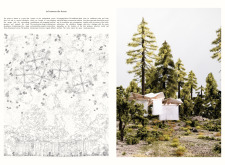5 key facts about this project
The pavilion serves multiple functions: it acts as an exhibition space, a venue for performances, and an area for community gatherings. By fostering engagement with the natural environment, the project elevates visitor experiences while also emphasizing the importance of ecological sensitivity in architectural practices.
Innovative Design Approaches
One of the standout features of the pavilion is its use of lightweight materials, which include fabrics and wood. The hanging fabrics serve not only as visual elements but also function as separators and connectors within the space. This choice allows for flexibility in the layout, granting visitors a unique experience as they move through the pavilion. The materials have been selected to both complement and reflect the textures found in the forest, enhancing the architectural relationship with its context.
The design strategy incorporates principles of traditional construction by utilizing local timber, which promotes sustainability and reduces the environmental impact associated with material sourcing. This connection to local building practices provides the pavilion with a sense of place and relevance within its geographical context.
Spatial and Structural Dynamics
The pavilion is characterized by open spaces that facilitate visitor movement between the different areas. This layout encourages exploration and interaction, creating a fluid experience that changes based on the visitor's perspective and the surrounding light. The arrangement of spaces allows for unobstructed views of the forest, reinforcing the connection between the internal environment and the external landscape.
The unique structural approach, which likely incorporates strategic use of steel or other metals, ensures both stability and support for the hanging elements. This careful consideration of structural integrity complements the overall design philosophy of merging architecture with nature, providing a unified and functional space.
For those interested in examining the architectural nuances of this project, further exploration of the architectural plans, architectural sections, and architectural designs will offer more detailed insights into the innovative ideas behind "In Between the Forest."























